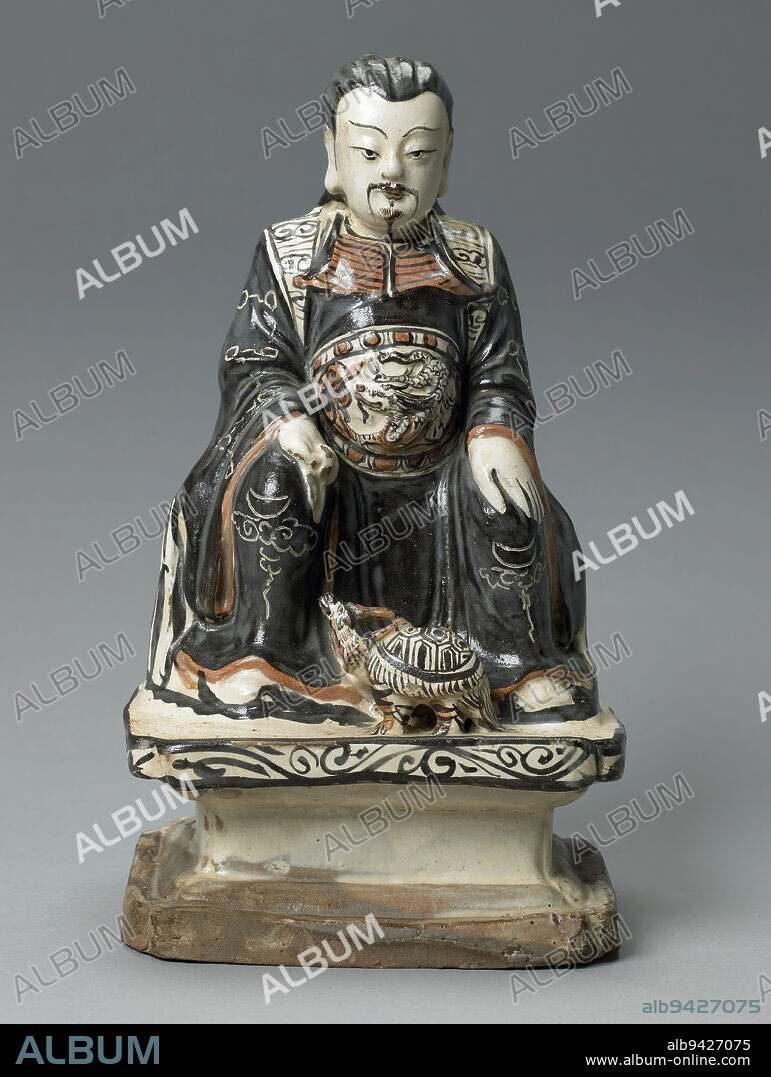alb9427075
Chen-Wu, The Taoist Deity of the North, 14th-15th century, 11 1/2 x 5 1/4 x 6 1/2 in. (29.21 x 13.34 x 16.51 cm), Tz'u-chou ware Slip-coated stoneware with dark brown and russet brown painted décor under a clear glaze., China, 14th-15th century, The origins of the deity Zhenwu (perfected warrior) go back to the Warring States (3rd century b.c.) and Han dynasty (206 b.c.-220 a.d.) periods. At that time, he was known as Xuanwu (the dark warrior), and was simply represented by a tortoise entwined by a snake. Xuanwu was the ancient symbol of the north and often appeared with three other animals: the dragon, red bird, and tiger, to symbolize the four directions. The transformation of Xuanwu from a snake-entwined tortoise to the Daoist deity Zhenwu, represented as a robust human-form warrior, occurred around 1000 a.d. The period of Zhenwu's greatest popularity was the Ming dynasty (1368-1644).

|
Add to another lightbox |
|
Add to another lightbox |



Buy this image.
Select the use:

Caption:
Chen-Wu, The Taoist Deity of the North, 14th-15th century, 11 1/2 x 5 1/4 x 6 1/2 in. (29.21 x 13.34 x 16.51 cm), Tz'u-chou ware Slip-coated stoneware with dark brown and russet brown painted décor under a clear glaze., China, 14th-15th century, The origins of the deity Zhenwu (perfected warrior) go back to the Warring States (3rd century b.c.) and Han dynasty (206 b.c.-220 a.d.) periods. At that time, he was known as Xuanwu (the dark warrior), and was simply represented by a tortoise entwined by a snake. Xuanwu was the ancient symbol of the north and often appeared with three other animals: the dragon, red bird, and tiger, to symbolize the four directions. The transformation of Xuanwu from a snake-entwined tortoise to the Daoist deity Zhenwu, represented as a robust human-form warrior, occurred around 1000 a.d. The period of Zhenwu's greatest popularity was the Ming dynasty (1368-1644).
Personalities:
Credit:
Album / quintlox
Releases:
Model: No - Property: No
Rights questions?
Rights questions?
Image size:
3604 x 4786 px | 49.3 MB
Print size:
30.5 x 40.5 cm | 12.0 x 16.0 in (300 dpi)
Keywords:
1000 A. D • 1368-1644 • 14TH-15TH CENTURY • 206 B. C.-220 A. D • 3RD CENTURY B. C • ANCIENT SYMBOL • ANIMAL • ANIMAL: SNAKE • ANIMALS • APPEARED • CHEN-WU • CHINA • CHINA: HAN DYNASTY • CHINE • CHINESE • CLEAR GLAZE • DAOIST DEITY ZHENWU • DARK BROWN • DARK WARRIOR • DEITY ZHENWU • DRAGON • DYNASTY: MING • FOUR DIRECTIONS • GO BACK • HAN DYNASTY • MING DYNASTY • NORDEN • NORTH • OCCURRED • ORIGINS • PERFECTED WARRIOR • PERIOD • PERIODS • PORCELAIN • RED BIRD • REPRESENTED • REPTILE: SNAKE • RETURN • ROBUST HUMAN-FORM WARRIOR • RUSSET BROWN PAINTED DÉCOR UNDER • SERPENT • SERPENTS • SIMPLY REPRESENTED • SNAKE SNAKE • SNAKE • SNAKE-ENTWINED TORTOISE • SNAKES • SYMBOLIZE • TAOIST DEITY • THREE • TIGER • TIME • TORTOISE ENTWINED • TRANSFORMATION • TZ'U-CHOU WARE SLIP-COATED STONEWARE • WARRING STATES • XUANWU • ZHENWU'S GREATEST POPULARITY
 Pinterest
Pinterest Twitter
Twitter Facebook
Facebook Copy link
Copy link Email
Email
